#usb microphone for podcasting
Explore tagged Tumblr posts
Text
Unleashing Professional Audio Quality with XLR Recording Microphones
In the world of audio recording, achieving professional-grade sound quality is paramount. Whether you're a musician, podcaster, filmmaker, or content creator, the choice of microphone plays a pivotal role in capturing clear, crisp, and immersive audio. Among the myriad of microphone options available, XLR recording microphones stand out as a preferred choice for professionals seeking unparalleled audio fidelity and versatility. In this article, we'll explore the features, benefits, and applications of XLR Recording microphone, shedding light on why they are a staple in the audio industry.
Understanding XLR Recording Microphones
XLR (which stands for "External Line Return") recording microphones utilize the XLR connector, a three-pin connection standard widely used in professional audio equipment. Unlike USB microphones commonly found in entry-level setups, XLR recording microphones offer a higher level of audio quality, flexibility, and control, making them a preferred choice for professional studios, live performances, and broadcast applications.
Features and Benefits
Superior Audio Quality: XLR recording microphones are engineered to deliver superior audio fidelity, capturing nuances and details with exceptional clarity and accuracy. With high-quality components such as condenser or dynamic capsules and low-noise circuitry, these microphones ensure pristine audio reproduction, making them ideal for critical recording tasks such as vocal performances, instrument tracking, and field recording.
Versatility: XLR recording microphones come in various types and configurations, catering to a wide range of recording needs. From large-diaphragm condenser microphones renowned for their warmth and sensitivity to dynamic microphones prized for their robustness and off-axis rejection, there's an XLR microphone suitable for every application, whether it's studio recording, live sound reinforcement, podcasting, or broadcast journalism.
Flexibility and Control: XLR microphones offer greater flexibility and control over audio capture compared to their USB counterparts. With XLR connectivity, users can leverage external audio interfaces, preamplifiers, and mixers to tailor the microphone's signal to their specific requirements, adjusting parameters such as gain, EQ, and compression for optimal results. This level of control empowers audio professionals to achieve the desired sound signature and sonic character, unleashing their creative potential.
Reliability and Durability: Built to withstand the rigors of professional use, XLR recording microphones are known for their reliability and durability. Constructed from robust materials and engineered for longevity, these microphones excel in demanding environments such as live performances, touring, and field recording, ensuring consistent performance even under challenging conditions.
Interoperability: XLR recording microphones adhere to a standardized connector format, facilitating interoperability with a wide range of audio equipment. Whether connecting to studio-grade preamps, mixers, audio interfaces, or stage equipment, XLR microphones offer seamless integration and compatibility, eliminating compatibility issues and simplifying setup and connectivity.
Applications
Studio Recording: XLR recording microphones are a staple in professional recording studios worldwide, favored for their superior audio quality and versatility. They excel in capturing vocals, acoustic instruments, drums, and other sound sources with unparalleled clarity and detail, making them indispensable tools for music production, voiceover work, and audio post-production.
Live Sound Reinforcement: In live performance settings such as concerts, conferences, and events, XLR microphones are essential for amplifying vocals and instruments with precision and fidelity. Whether used for lead vocals, instrument miking, or ambient miking, XLR microphones ensure optimal sound reinforcement and audience engagement.
Broadcast and Podcasting: XLR recording microphones are widely used in broadcast and podcasting applications, delivering professional-grade audio for radio shows, interviews, podcasts, and voiceover recordings. Their exceptional sound quality, reliability, and flexibility make them preferred choices for broadcasters, journalists, and content creators seeking to elevate their productions.
Field Recording and Location Sound: XLR microphones are indispensable tools for field recording and location sound capture, allowing audio professionals to capture natural sounds, environmental ambience, and on-location dialogue with clarity and realism. Whether recording wildlife, sound effects, or dialogue for film and television productions, XLR microphones provide unmatched versatility and performance.
Conclusion
In summary, XLR recording microphones represent the pinnacle of audio recording technology, offering unparalleled audio quality, versatility, and control. Whether you're recording in the studio, performing live on stage, broadcasting to the masses, or capturing sounds in the field, XLR microphones empower you to achieve professional-grade results with confidence and precision. With their superior audio fidelity, reliability, and interoperability, XLR recording microphones are indispensable tools for audio professionals and enthusiasts alike, elevating the art of sound capture to new heights.
For more details, visit us:
usb microphone for podcasting
dynamic microphone
podcasting kit
usb condenser mic
0 notes
Text
Many people ask which setup should they use for podcasting. You don’t need to invest in pricey equipment to achieve high-quality audio. Many successful podcasts use a simple setup.
Let’s explore key factors when choosing a podcast, followed by our top equipment recommendations.
Develop a podcast concept. Define your goals. Pick a podcast theme or topic. It’s important to know your why, even if it’s to have fun with friends.
Ask yourself what gives you energy. Do you love connecting with podcast guests, or do you feel your best going solo? Because that would indicate which setup you should have for the podcast.
If you choose to have cohosts, try to keep your group small. Podcasting with more than two or three people makes scheduling a challenge.
Keep in mind that some shows require more production than others. For instance, fiction podcasts usually require more editing than interview podcasts.
ONE-PERSON SETUP
Samson Q2U | $70
Pop Filter | $6-30
Any headphones you already have
PODCAST SETUP FOR TWO
Samson Q2U | $70 (x2)
Audio Technica M20x | $50 (x2)
Focusrite Scarlett 2i2 | $160
Pop Filter | $6-30
PODCAST SETUP FOR THREE
Samson Q2U | $70 (x3 or 4)
Audio Technica M20x | $50 (x3 or 4)
RODECaster Pro | $600
Pop Filter | $6-30
The Zoom P4, priced at $200, serves as a budget-friendly alternative to the RODECaster Pro.
Read the full blog: https://www.soundorp.com/beginner-podcast-setup/
2 notes
·
View notes
Text
Microphone à condensateur RØDE NT-USB
Profitez d'une remise exceptionnelle de 55% sur le microphone USB RØDE NT-USB, un outil polyvalent de qualité studio, parfait pour le streaming, les jeux et la production musicale. Ce micro à condensateur est conçu pour offrir un son riche et professionnel, tout en étant simple à utiliser et à configurer.

Microphone à condensateur RØDE NT-USB - LaRevueGeek.com
#microphone USB#condensateur#studio#RØDE NT-USB#streaming#jeux#podcasts#production musicale#filtre anti-pop#trépied#haute qualité#compatible PC Mac#remise 55%
0 notes
Text
Microphone
Buy Now
Click Here
#microphone#usb microphone#best budget microphone#best usb microphone#condenser microphone#best microphone#best microphone for youtube#maono microphone#best microphone for streaming#microphone review#karaoke microphone#dynamic microphone#wireless microphone#usb microphone review#microphone comparison#best podcast microphone#best budget usb microphone#best microphone for gaming#best microphone for podcasting#r#gb microphone#$#13 microphone
1 note
·
View note
Text
FIFINE XLR/USB Dynamic Microphone
🎤 New blog post alert! Dive into my review of the FIFINE XLR/USB Dynamic Microphone. Perfect for podcasters, streamers, and more! #PodcastGear #MicrophoneReview #Podcasting #Streaming #AudioGear
Visit the FIFINE Store Color: BlackRecommended: Streaming, Podcast, Vocal, Recording, GamingBrand: FIFINEModel Name: AMPLIGAME AM8Connectivity Technology: USB, XLRConnector Type: USB, XLRSpecial Feature: Headphones Jack, Monitoring Volume Control, Buitin 3/8″ and 5/8” Threads, RGB Lights, RGB Control Key, Volume Control, Mute Function, XLR/USB ConnectionCompatible Devices: Laptop, Desktop,…

View On WordPress
#Affordable microphone#Best microphone under $50#Budget microphone#Dynamic microphone#FIFINE microphone#FIFINE microphone review#FIFINE microphone setup#FIFINE tech#FIFINE XLR/USB dynamic mic#FIFINE XLR/USB microphone#Microphone comparison#Microphone for beginners#Microphone for streaming#Microphone review#Podcast microphone#Recording microphone#Studio microphone#USB condenser microphone#USB microphone#XLR microphone
0 notes
Text
youtube
#logitech#logitech g#yeti gx#microphone review#microphones#usb microphone#youtube#tech review#youtube video#microphone#streamers#streaming#audio equipment#podcasting#youtube channel#audio#Youtube
0 notes
Text
Blue Yeti Microphone Review: Is It Worth the Hype?
Is the Blue Yeti the ultimate mic for content creators? We dive deep into its features, uses, and potential drawbacks in our comprehensive Blue Yeti microphone review.
The Blue Yeti: Debate, Hype, and Your Audio Upgrade The Blue Yeti microphone review is here. Blue yet has become a fixture in the world of content creation. You’ve seen it on YouTube, heard it on podcasts, and perhaps even considered grabbing one for yourself. But amidst the hype and passionate opinions—both for and against—it’s hard to know if the Blue Yeti is truly the right tool for the…

View On WordPress
#best budget microphone#blue yeti microphone#blue yeti microphone review#blue yeti vs razer seiren x#blue yeti vs rode n50usb#blue yeti vs samson q2u#blue yeti vs shure sm7b#condenser microphone#podcasting microphone#streaming microphone#usb microphone
0 notes
Text
The Wireless Microphone Revolution
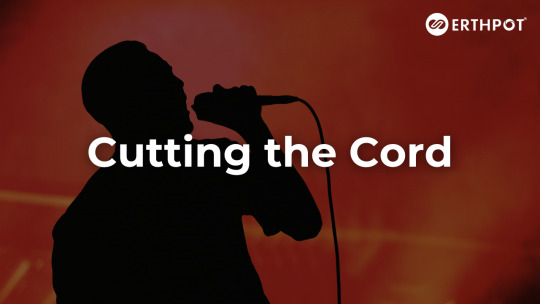
The emergence of wireless mics is a subtle revolution in sound technology in a world where cords and wires are commonplace. It's time to welcome the freedom that the wireless microphone revolution offers to the table and wave goodbye to tangled connections and limitations.
Why Use a Wireless Device?
The attraction of wireless microphones is their capacity to release speakers and performers from the limitations of conventional wired arrangements. Severing the connection unlocks a plethora of opportunities for those in the music, presentation, or content creation industries. Imagine being able to interact with your audience while gliding over the stage without the need for a cord.
Uninterrupted Communication
The smooth communication of wireless mics is one of their main benefits. You can stop worrying about getting caught in a maze of wires or stumbling over cords while performing live. You can concentrate on doing your best work instead of worrying about being physically linked thanks to wireless technology.
Adaptability in Motion
No other microphone allows you more mobility than a wireless one. Speakers may move around the crowd, performers can traverse the stage, and content makers can record without being restricted to one location. A dynamic and engaging experience that enthrals both the artist and the audience is made possible by the wireless revolution.
Getting Used to the Digital Era
As the digital era advances, wireless microphones continue to be indispensable tools. They are flexible tools for online broadcasting, virtual events, and content creation since they easily interface with a wide range of digital devices. Accept the ease of wireless technology as you adjust to the always changing digital communication environment.
In summary, welcome the future of sound
Not only a fad, the wireless microphone revolution is fundamentally altering the game. Cut the connection, release yourself from constraints, and reach new levels with your presentation or performance. Welcome to a world where excellent audio quality combines with freedom of movement and complexity. Embrace the change and discover the freeing potential of wireless microphone-your pass to an endless audio experience without cords
0 notes
Text
2025 Audio Fiction Convention
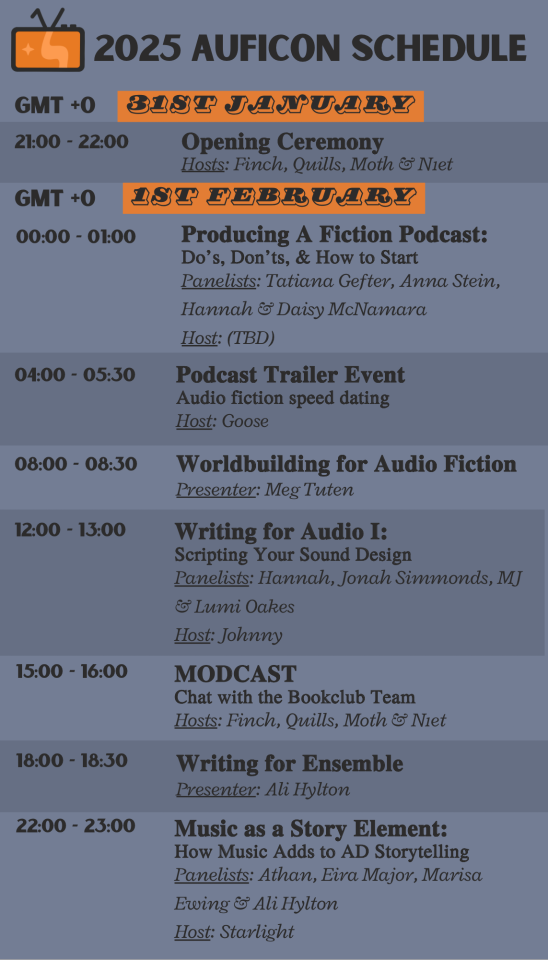
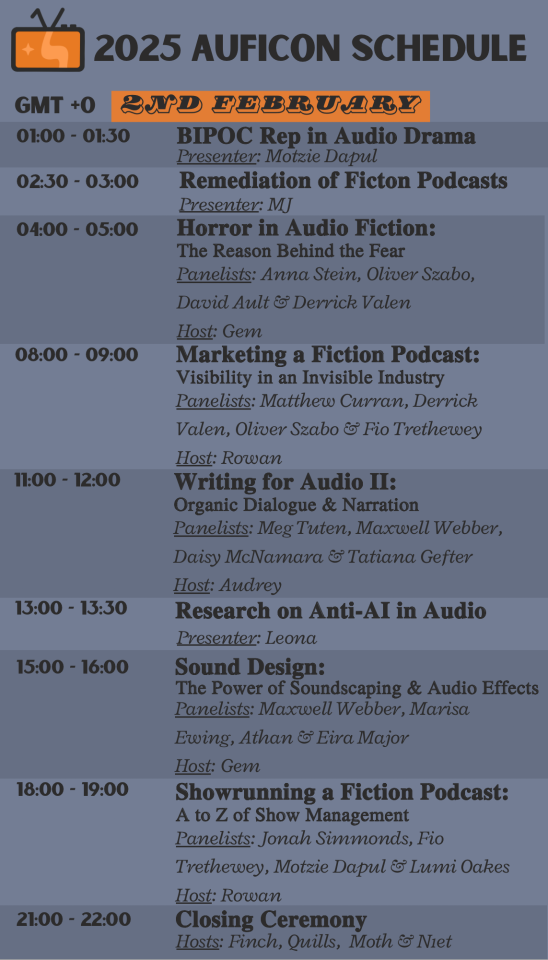
AuFiCon is almost upon us! For those that don't know, AuFiCon is a virtual community event hosted by the Podcast Book Club. Panels will be run over Twitch, with our Discord server hosting most everything else. The con is scheduled on a 24-hour basis to accommodate as many timezones as possible (with the schedule above listed in GMT), and events will be recorded for those that can't catch the live panels.
If you'd like to pick up a free ticket, you can do so on our EventBookings page, with the option to upgrade to a donation ticket if you'd like.
Additionally, we'd like to announce that we will be hosting an equipment giveaway during the convention! We here at the PBC are deeply appreciative of the opportunities we've been given through starting this community, and wish to give back to members who otherwise may not have access to podcasting equipment. One winner will receive a RODE NT-USB+ microphone and PSA 1+ studio boom arm. To enter:
Reblog this announcement post here on Tumblr
Complete the giveaway form here.
Finally, we are organizing a trailer event to showcase new, upcoming, and well-loved audio dramas during the convention. If you are involved in the creation of a podcast and would like your show's trailer to be played on the Podcast Trailer Event Twitch stream on the 1st of February at 4:00 PM GMT, please submit the trailer form here. (Submissions will be accepted until 26 January, 2025 at 11:59 PM EST.)
#podcast book club#con updates#2025 auficon#2025 audio fiction convention#audio drama#fiction podcast#audio drama sunday
280 notes
·
View notes
Note
Curious what's your grudge with sm7b is.
Like, imo, if one microphone had to become popular, sm7b is one of the better options. It's well-liked among professionals for its frequency response and smoothness, the fact that it's a dynamic microphone means that it sounds good even in poorly treated environments (picks up less room echo).
I think it's a really versatile mic. Ofc there are better options for certain situations. But you can't trust each person to research everything, esp cuz it could lead to them picking an even worse option. At least it's not blue yeti anymore
The SM7B is a fantastic microphone, but it is a pain in the ass.
It's very insensitive, which is great for dynamic singers who go from quiet to loud, but for a regular speaking voice it needs a cloud lifter to boost the gain. Even then it needs to be relatively close to the mouth. It's XLR, which is another hassle. It has a shitty pop filter and no real shock absorption. And it really needs EQ to sound its best.
All of that can be overcome, but I just think it is a lot of work for a simple podcast setup. A USB microphone just makes a lot more sense to me for most people. Though I agree the Yeti is a travesty. It's trying to be too many things at once and doesn't do one thing very well.
I also think aesthetics should be a concern, especially since a lot of podcasts have a video version. Some may disagree, but I think the SM7B is an ugly mic. And it is so large and unwieldy that it usually blocks half of the face.

And there are so many really beautiful mics that sound just as good or better. If people have good sound absorption in their recording space, they could use a more sensitive mic and place it farther away so it doesn't block the face.
I really like the Earthworks Icon.

I just think that is a gorgeous mic and I like the sound better than the Shure.
But there are tons of really beautiful options.
For video, people could also do a high quality lav mic or a shotgun mic out of frame. They don't need to have any visible microphone and they can still get very good sound quality.
And if they only care about the absolute best sound quality, picking out a mic should be a personal thing. I feel folks shouldn't just get what everyone else is getting. They should get something that specifically suits their voice. For example, if you have a deep baritone and want that boomy radio voice, perhaps get a broadcast microphone with good proximity effect. Different mics suit different vocal ranges and people rarely consider that.
There are so many amazing microphones out there and every single podcaster is limiting themselves to the biggest, ugliest, and hardest to use option.
I think folks should stop following this fad and do a little research to find a microphone that specifically suits their needs. They should listen to sample recordings featuring a similar voice to their own. They should consider ease of use, aesthetics, and sound quality. They may find the SM7B works best for them. And I would have no problem with that. But if I were investing that much money, I would want to be sure it was the best option for me.
I really like EposVox for mic reviews. He focuses on their use for streaming and podcasting. But I would still seek out sample recordings matching one's vocal range.
23 notes
·
View notes
Note
what equipment would you recommend for someone wanting to start voice acting but who is also very broke and not able to invest in the expensive stuff? i want things to sound nice! i also want to still be able to buy groceries lol.
and in general any advice for getting started voice acting?
hi!! i got another anon in this vein, so i'm gonna combine them and answer both of y'all at once!
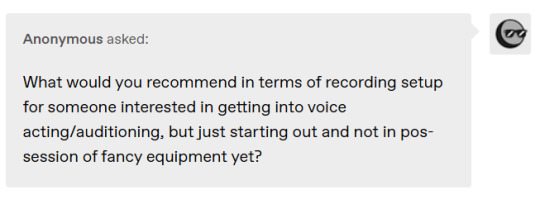
don't worry about expensive/fancy equipment when you start out! i started with an old snowball USB microphone, huddled under a duvet on my bed and recording on audacity. it definitely wasn't the fanciest (or the most comfortable, it gets hot under duvets), but it was good enough to start! and i still record on audacity, which is a totally free program of course, you might not have an old USB mic lying around. if you're looking to buy something, check out second-hand mics from places like guitar center and sweetwater. most of them work great, and they're much cheaper! (about 20-25 USD, from a quick glance.) make sure you have some earbuds at least, too, just in case you get called in for a group recording!
at LEAST half of your audio quality is gonna come from the space you record in, but that doesn't have to cost money. get under thick blanket or in a closet filled with clothes! the more soft stuff, the better
if you don't have the funds for a second-hand mic, or if you don't live in a space where you get very much quiet time, you're not out of luck. check out your local library! some libraries rent equipment out, and--even better--some have podcast recording studios you can use! all for free!
whatever equipment you can manage, just go for it! try out for projects that look fun, read scenes with your friends or monologues by yourself, and don't be afraid to get silly with it 💕
10 notes
·
View notes
Text
Unlocking Crystal-Clear Sound: The Power of USB Condenser Microphones
In the dynamic world of audio recording, clarity and precision are paramount. Whether you're a seasoned podcaster, a budding musician, or a professional content creator, the quality of your audio can make or break your project. One crucial tool that has revolutionized the way we capture sound is the usb condenser mic. In this article, we'll delve into the features and benefits of USB condenser mics, exploring how they've become the go-to choice for many in the recording industry.
Understanding USB Condenser Microphones:
Condenser microphones are a type of microphone known for their sensitivity and ability to capture a wide range of frequencies. Unlike their dynamic counterparts, condenser mics are ideal for capturing nuanced details in vocals and instruments. The integration of USB technology takes these advantages to a new level, making them more accessible and user-friendly for a diverse range of applications.
Plug-and-Play Convenience: One of the most significant advantages of USB condenser microphones is their plug-and-play functionality. Traditional microphones often require complex setups with audio interfaces and mixers, adding an extra layer of complexity for beginners. USB condenser mics simplify the process – just plug the microphone into a USB port, and you're ready to record. This accessibility has democratized high-quality audio recording, allowing individuals without extensive technical expertise to achieve professional results.
Portability and Versatility: USB condenser microphones are designed with portability in mind. Their compact and lightweight nature makes them perfect for on-the-go recording. Musicians can capture inspiration wherever it strikes, podcasters can conduct interviews on location, and content creators can easily set up a mobile recording studio. The versatility of USB condenser mics expands the possibilities for creative expression, breaking down barriers to recording in different environments.
Quality Audio Output: The heart of any condenser microphone is its ability to capture crisp and clear audio. USB condenser mics excel in delivering studio-quality sound without the need for an extensive setup. With built-in analog-to-digital converters, these microphones translate analog signals into digital data with precision. This ensures that every nuance of a vocal performance or musical instrument is faithfully reproduced, providing a professional-grade audio experience.
Cost-Effective Solutions: Traditional studio setups can be expensive, requiring an assortment of equipment to achieve optimal results. USB condenser microphones offer a cost-effective alternative without compromising on quality. By eliminating the need for additional gear and complex configurations, these microphones provide an affordable entry point for aspiring musicians, podcasters, and content creators looking to invest in high-quality audio recording.
User-Friendly Features: USB condenser microphones often come equipped with user-friendly features that enhance the recording experience. Many models include adjustable gain controls, headphone jacks for real-time monitoring, and mute buttons for added convenience. These features empower users to tailor their recording setup to their specific needs, making the process more intuitive and enjoyable.
Conclusion:
The USB condenser microphone has undeniably transformed the landscape of audio recording, making professional-quality sound more accessible to a broader audience. Whether you're a musician capturing your latest composition, a podcaster sharing your voice with the world, or a content creator producing engaging videos, the convenience, portability, and exceptional audio quality of USB condenser microphones are reshaping the way we approach recording.
As technology continues to advance, we can anticipate further innovations in USB condenser microphone design, pushing the boundaries of what is possible in the realm of audio recording. Embrace the power of USB condenser microphones and unlock the potential for crystal-clear sound in your creative endeavours.
For more details, visit us :
mic stands
microphone headset
podcasting kit
0 notes
Text
What are the Best USB Mics Models under $150?
Let’s talk about a variety of all best USB mics under 150$, covering everything from budget-friendly options to more premium models. We’ll be exploring each mic’s features, sound quality, and value for money, helping you decide which one suits your needs and select the best USB mic.
USB mics give convenience and accessibility, especially for those seeking a simple plug-and-play solution for recording audio. However, as with any technology, there are often trade-offs to consider. While USB mics like the one described may offer good recording quality and unique features, they can also come with drawbacks such as complicated software interfaces, issues with background noise, and challenges with customer support.
Blue Yeti X
Our first microphone is the Blue Yeti X, a popular choice among streamers and podcasters. Priced around $139 on Amazon, it’s on the higher end of our price range. This microphone is incredible for VO/Interviews/Content Creators. The stand is a bit short — I wish it had the ability to extend. Sound quality is great so unless you’re an audiophile, you’ll love this and be impressed.
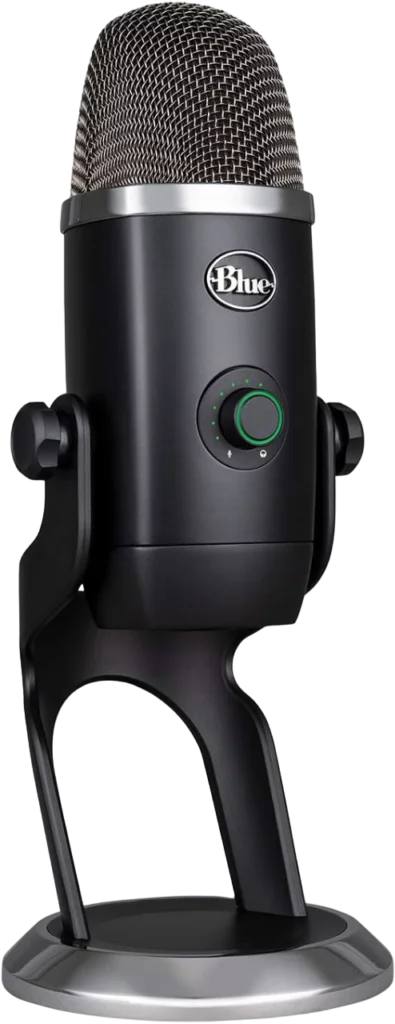
Razer Seiren V2 Pro
Next, we have the Razer Seiren V2 Pro, priced at $149. It’s another mic designed with streamers in mind, featuring comprehensive software support through Razer Synapse.
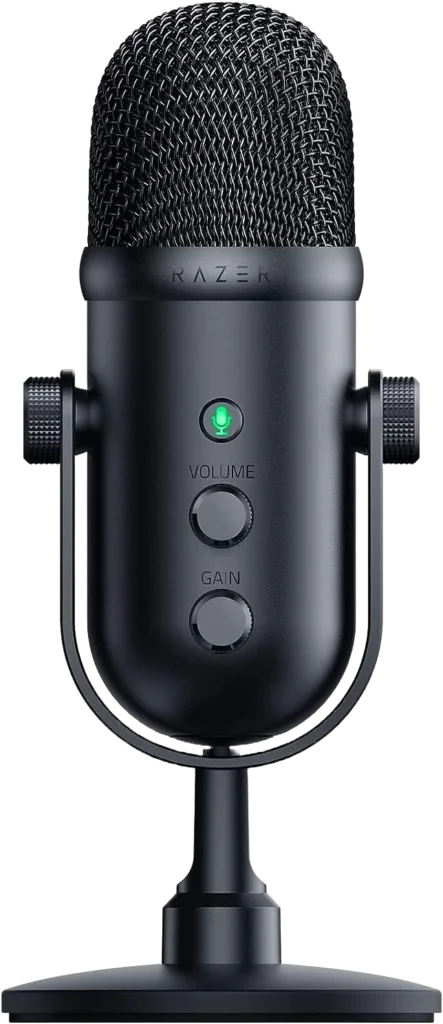
The Rode NT-USB Mini is designed for podcasters and streamers, priced at $98. This mic provides a solid build and useful features made for professional audio recording.
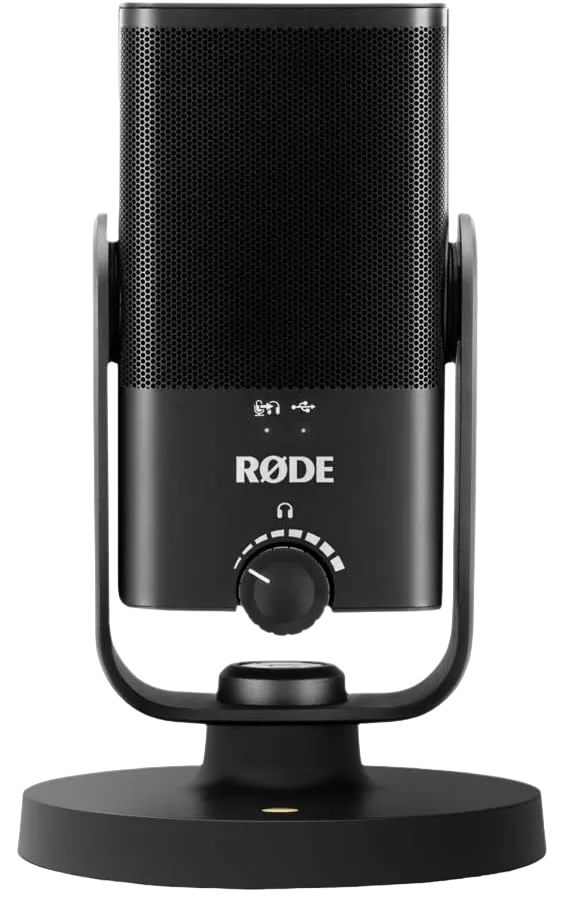
Logitech for Creators Blue Yeti USB Microphone
Creators and professionals understand the necessity of crystal-clear sound on their podcasts, gaming streams, and YouTube videos. The Logitech for Creators Blue Yeti USB Microphone has emerged as a popular choice, promising studio-quality sound and ease of use. In this review, we’ll talk about the details to uncover whether this microphone lives up to the hype.
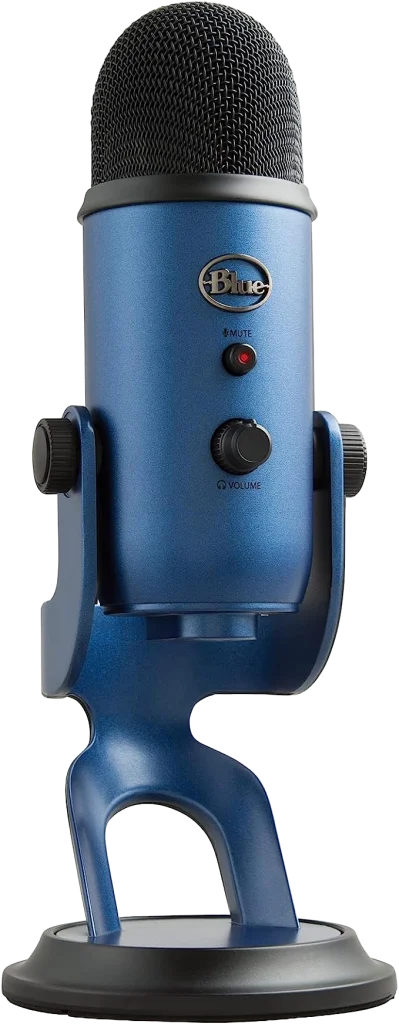
HyperX QuadCast
The HyperX QuadCast stands out with its distinctive RGB lighting and solid performance at $109. This mic is larger but not overly heavy, and it comes with a built-in shock mount to reduce vibrations. It has a touch-sensitive mute button on top and allows you to adjust the sensitivity and polar pattern, with cardioid being the preferred setting for most uses.
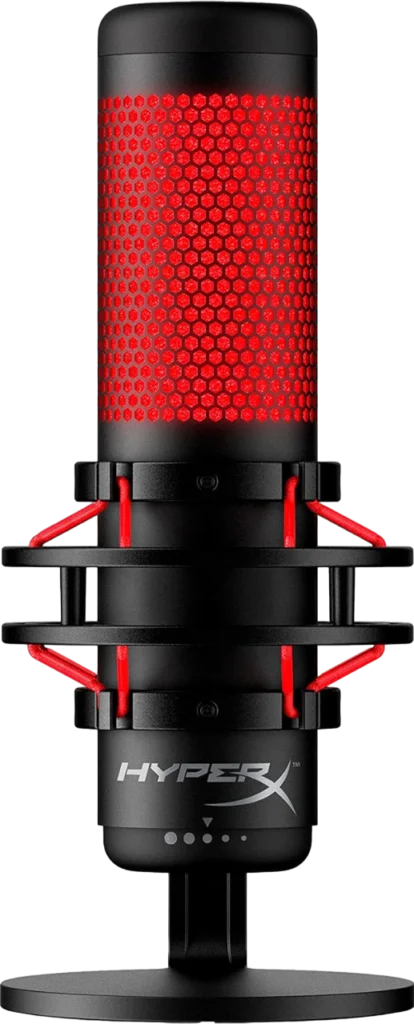
FIFINE XLR/USB Dynamic Microphone
In podcasting, Streaming, and content creation, a good microphone is significant for delivering top-notch audio quality. We now talk about the FIFINE XLR/USB Dynamic Microphone, a versatile piece of audio equipment making waves in the industry. In this review, we’ll explore the features, pros, and cons to help you make an informed decision.
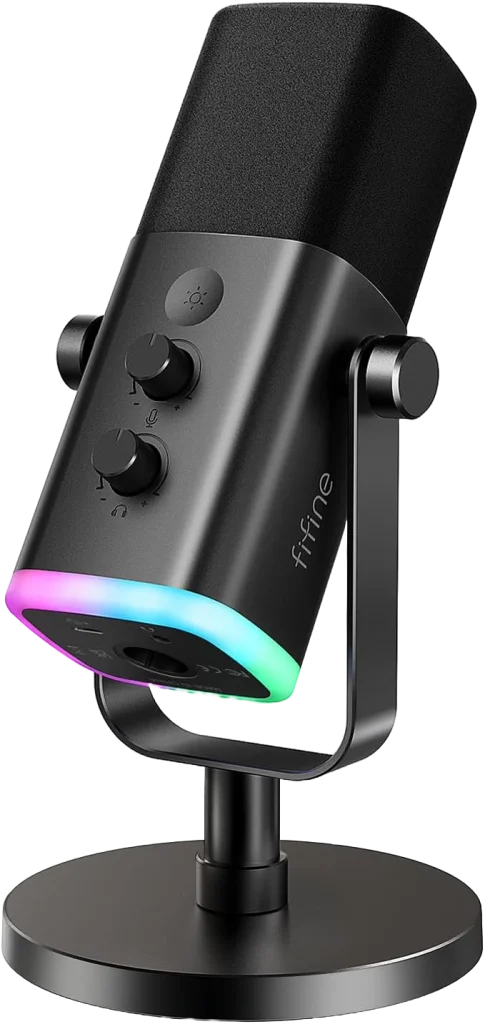
Learn more about Fifine and Blue Yeti Mics in this Blog.
Audio Tests and Comparisons of some USB Mics
To give you a better idea of how each mic performs, here are audio samples from each:
Blue Yeti X:Without presetsBroadcaster 1 presetBroadcaster 2 presetWarm and Vintage preset
Razer Seiren V2 Pro:Without high-pass filter With high-pass filter
Rode NT-USB Mini:Without effects With effects
HyperX QuadCast:Default sound With VST plugin adjustments
To get the detailed analysis and user reviews and criticisms on the above mics read the full article on Best USB Mics Models under $150 by going through the link
Conclusion
In summary, I will say each of these USB mics has their unique advantages, catering to different needs and budgets. So, if you want to get one of the best USB Mics, I’d just go with the features of the mics that fits your needs the most.
When purchasing a USB microphone, it’s essential to weigh the pros and cons carefully. Assess your specific needs and preferences, including recording quality, ease of use, and technical support. Additionally, reading reviews and seeking recommendations from other users can provide valuable insights into the overall performance and reliability of a particular USB microphone.
Into Podcasting? Podcasting is a different game, and without a precise blueprint, the game will get tougher midway. Grow your podcast from scratch with Zero Audience and learn about how successful podcasters cracked the code by winning our Free Guide with step by step Guidelines.
Get your complete podcast equipment setup by visiting Podcast Equipment Bundle. Get in touch with podcasting services and experts those will save you tons of time at Podcast Production Services.
With that being said, Let’s connect with all such free and paid tool/services you might need knowingly or unknowingly to fuel your growth. Here’s 21 BEST AI TOOLS AND PLATFORMS TO GROW YOUR PODCAST AND CONTENTS. There are some bonus tools in the end too to make your day to day life easier.
0 notes
Text
Microphones Blue Yeti, Micro USB pour Enregistrer, Streaming, Gaming, Podcast, PC & Mac - Noir
Profitez maintenant d'une réduction exceptionnelle de 36% sur le microphone USB Blue Yeti, l'outil idéal pour le streaming, les podcasts, et plus encore. Cet appareil haut de gamme de Logitech for Creators offre une flexibilité et une qualité sonores incomparables.

Microphones Blue Yeti, Micro USB pour Enregistrer, Streaming, Gaming, Podcast, PC & Mac - Noir - LaRevueGeek.com
#Blue Yeti USB Mic#microphone USB#streaming#podcasting#Blue VO!CE#directivité multiple#Plug and Play#Logitech for Creators#qualité sonore de diffusion#compatible PC et Mac
0 notes
Text
Last Monday of the Week 2025-05-12
So much movie
FORGOT TO POST THIS LAST NIGHT BLEGH
Listening: Podcast that I'm not endorsing but that I have started; Not So Quiet on the Western Front, a WWI podcast that at least starts as "Discussion of various battles, mostly English" but looks like it broadens out later.
My like, individual moment to moment knowledge of WWI is pretty bad, so I thought this would be fun.
Reading: Red Mars, I love Nadia with all my heart.
Every few months I end up reading a bunch of USB spec summaries in order to make sense of some bizarre bullshit I'm trying to do on my computer. This time around I found this handy series on USB
USB is not an exceedingly complicated protocol but it has a lot of distinct modes it can operate in and each mode uses the different transports available to it for different things. You will never want to read the word "isochronous" ever again.
Playing: More Skin Deep, currently stuck on I think the one after the mining vessel? Early Skin Deep levels do not ask you to really master your equipment because you can usually just stun pirates and bash them into things. Later levels add more and more elite pirates who can't be bashed, forcing you into cleverer and cleverer approaches.
The other thing about elite pirates is that they have rocket launchers instead of guns so my favourite trick (create a flammable cloud and trick a pirate into shooting at me from inside it so they explode) doesn't work reliably.
In general the later missions change from "action stealth" to "stealth puzzle" as your resources get more constrained and the lethality of the pirates rises. There's also more missions that put you up against very specific limits, like making the only way between parts of the ship early on be through trash chutes. I think I'm going to have to start not killing every pirate.
Watching: Conclave, on account of the situation. It's a good looking movie! It's an effective location to set a drama/thriller in! It spins up a lot of plot threads and discards them to make you go "would that be fucked up or what?" which I think lands for such an insular group, like, do we actually care if one of them murdered the pope? Maybe! But ultimately one of them has to be the pope at the end so we have to solve this first.
Also Fast & Furious 6, as part of the ongoing Watch Through. Book report to follow, but this one ain't a heist movie! It's the opposite of a heist. They can't keep getting away with it (changing genre every movie)
Making: Prints around the house again, this time trying to figure out how to mount a microphone and tablet near my desk. I have discovered that tablet in question has a set of astoundingly strong magnets that allow it to basically stick to any steel surface so I might try and exploit that. Still trying to figure out if it's possible to print a half-decent shock mount but I might have to actually use elastic bands at some point.
Tools and Equipment: I have had a box of powdered milk kicking around because I needed some for a bread thing and I have been using it mostly to make tea and occasionally cereal. It's okay! You can just toss a spoonful straight into some breakfast tea and it'll do the thing! Bviously this is not novel, this is the whole reason condensed milks and powdered milks exist (other than for industrial applications) but it is pretty good at it. If you're like me and basically go through dairy milk at a liter every month or so, powdered milk is a good way to keep it on hand without having to buy those tiny bottles. Do try and get full fat powdered milk though I had to get part-skim for this because it was the only one they had and what's the point really.
7 notes
·
View notes
Text
The Røde NT-USB Mini is a lovely little podcast mic (2025)
4 notes
·
View notes